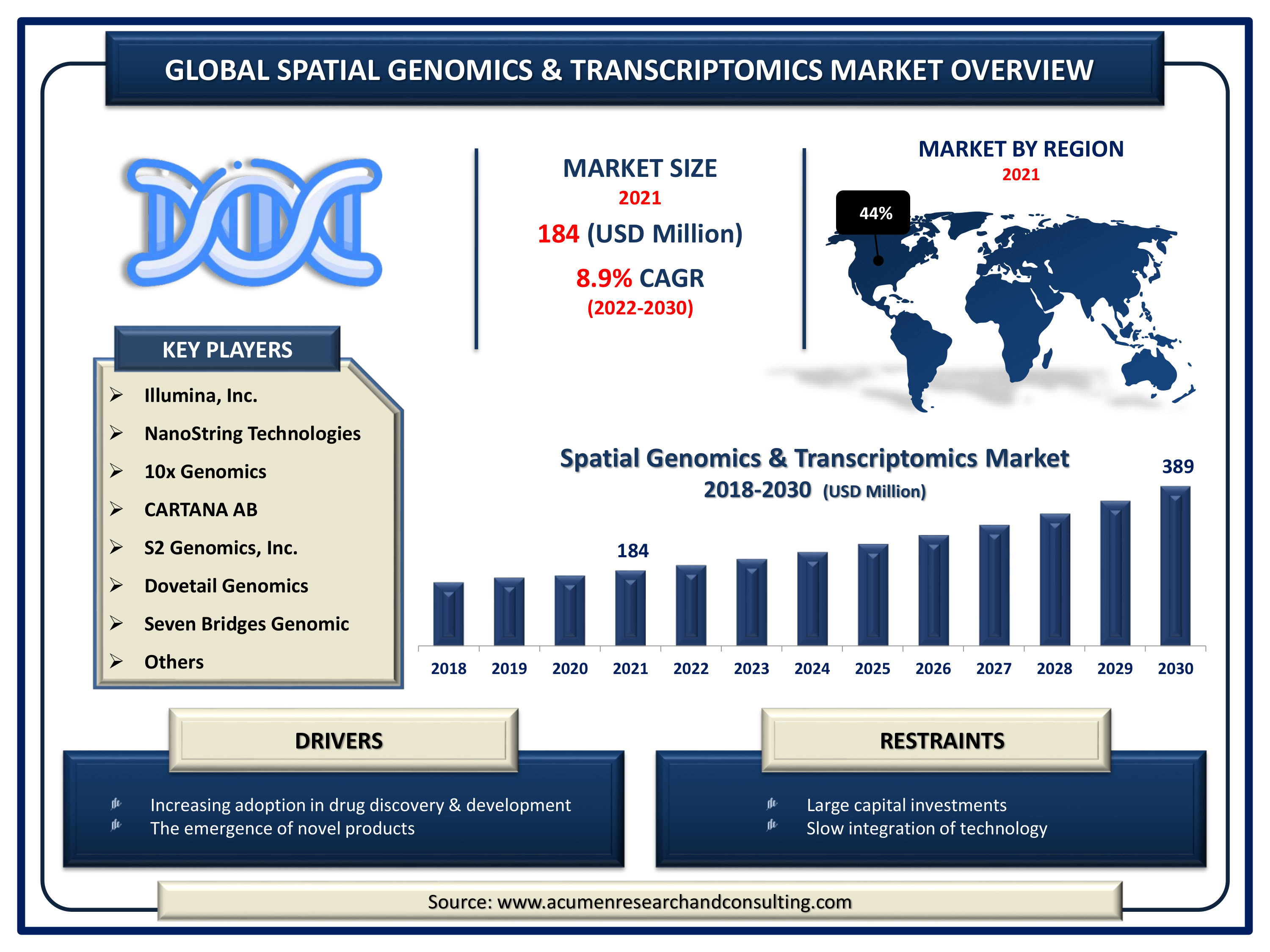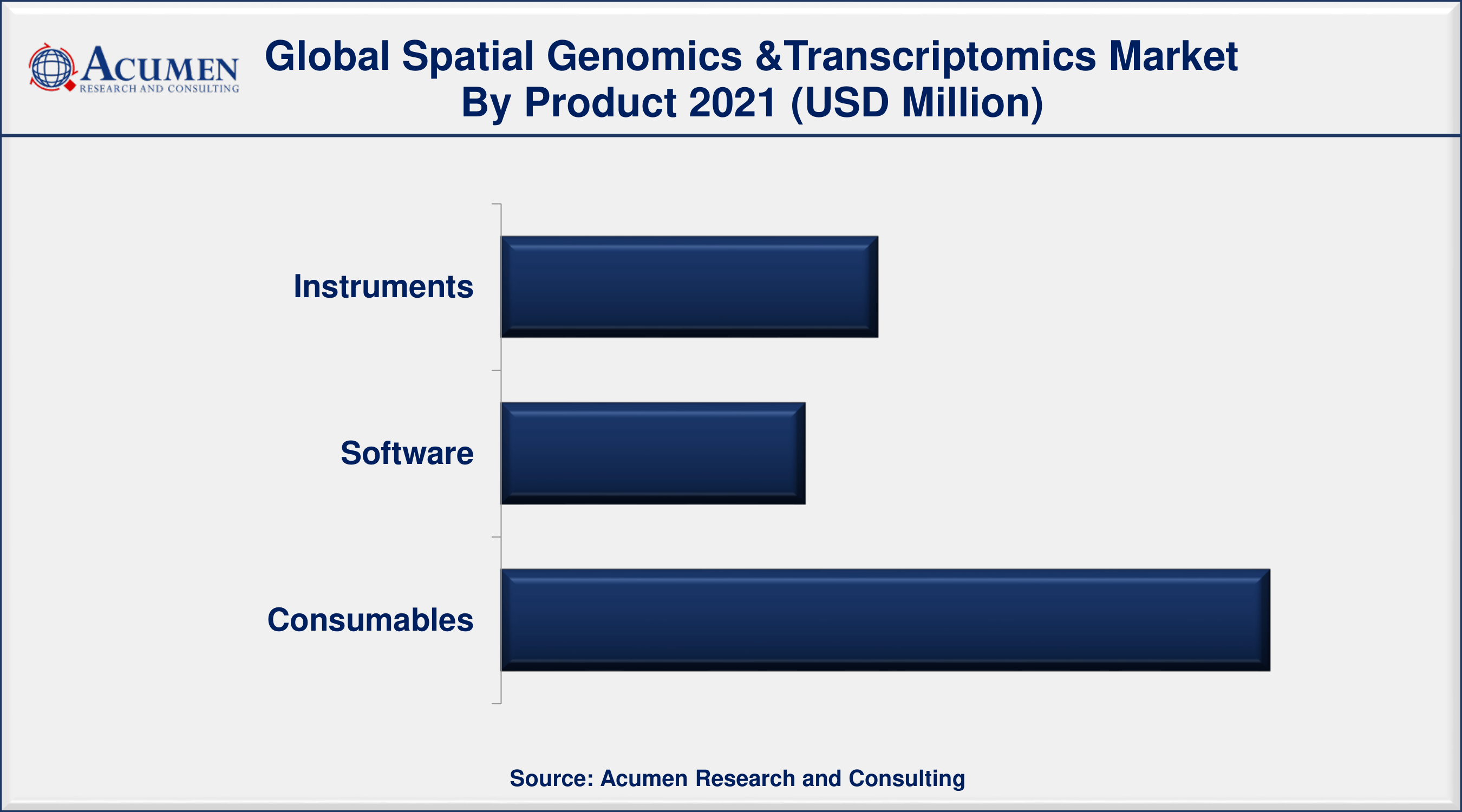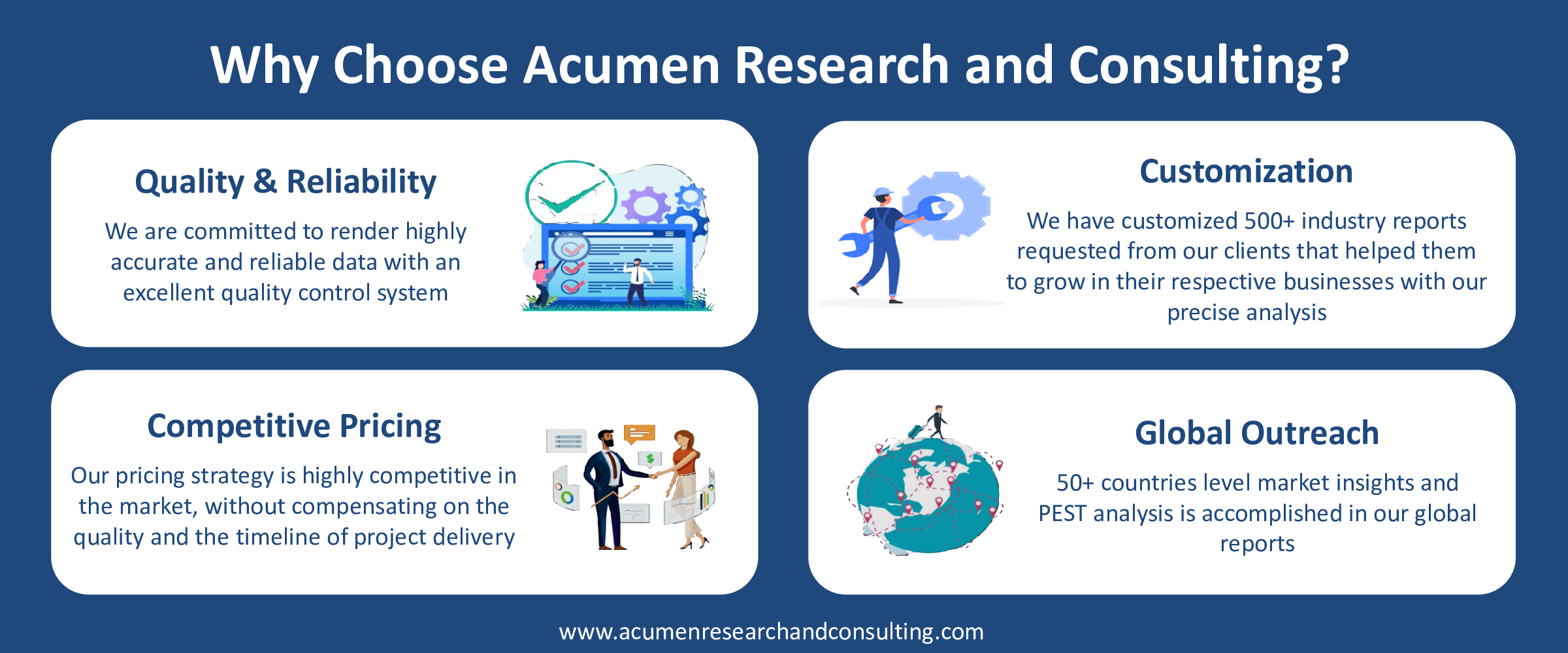Spatial Genomics And Transcriptomics Market | Acumen Research and Consulting
Spatial Genomics and Transcriptomics Market Size - Global Industry, Share, Analysis, Trends and Forecast 2022 - 2030
Published :
Report ID:
Pages :
Format : ![]()
The Global Spatial Genomics & Transcriptomics Market Size accounted for USD 184 Million in 2021 and is estimated to achieve a market size of USD 389 Million by 2030 growing at a CAGR of 8.9% from 2022 to 2030. The increasing prevalence of genetic illnesses such as cancer, neurological disorders, and other diseases will provide enormous growth potential for the spatial genomics and transcriptomics markets value. Furthermore, technological improvements in the genetic engineering sector will be critical in driving the spatial genomics and transcriptomics market growth over the forecasting years.

Spatial Genomics & Transcriptomics Market Report Key Highlights
- Global spatial genomics & transcriptomics market revenue is expected to increase by USD 389 million by 2030, with 8.9% CAGR from 2022 to 2030.
- North America spatial genomics & transcriptomics market led with more than 44% market share in 2021
- Europe is expected to grow at a moderate pace and have a substantial market revenue share in 2021
- Among technology, spatial transcriptomic segment engaged more than 80% of the total market share in 2021
- By end-use, the academic customers segment has reached 58% market share in 2021
- Based on product, the consumables segment has contributed significant market share in 2021
Spacious genomics & transcriptomics enable researchers to see not just what is in a cell, but how cells are organized in relation to each other. The data which was previously beyond the scope of modern methods offer invaluable insights into the understanding of a disease. Spatial genomics & transcriptomics include transcriptome exploration and assortment. It has various applications, mainly in the field of molecular genetics. There are many cases of fresh product launches in the worldwide space genomics & transcriptomics industry.
Global Spatial Genomics & Transcriptomics Market Dynamics
Market Drivers
- Increasing adoption in drug discovery & development
- The emergence of novel products
- Rising R&d spending and public-private collaboration
- The rising potential of spatial genomic analysis as a cancer diagnosis technique
Market Restraints
- Large capital investments
- Slow integration of technology
Market Opportunities
- The gradual introduction of single-cell sequencing
- Growing utilization of spatial omics for biomarker identification
Spatial Genomics & Transcriptomics Market Report Coverage
| Market | Spatial Genomics & Transcriptomics Market |
| Spatial Genomics & Transcriptomics Market Size 2021 | USD 184 Million |
| Spatial Genomics & Transcriptomics Market Forecast 2030 | USD 389 Million |
| Spatial Genomics & Transcriptomics Market CAGR During 2022 - 2030 | 8.9% |
| Spatial Genomics & Transcriptomics Market Analysis Period | 2018 - 2030 |
| Spatial Genomics & Transcriptomics Market Base Year | 2021 |
| Spatial Genomics & Transcriptomics Market Forecast Data | 2022 - 2030 |
| Segments Covered | By Product, By Technology, By End-Use, And By Geography |
| Regional Scope | North America, Europe, Asia Pacific, Latin America, and Middle East & Africa |
| Key Companies Profiled | NanoString Technologies, 10x Genomics, CARTANA AB, Horizon Discovery Group plc, Illumina, Inc., S2 Genomics, Inc., Dovetail Genomics, Seven Bridges Genomic, and Advanced Cell Diagnostics. |
| Report Coverage |
Market Trends, Drivers, Restraints, Competitive Analysis, Player Profiling, Regulation Analysis |
Spatial genomics & transcriptomics is a rather new discipline involving the identification of high-performance information concerning the organizational composition of tissue and cell content. Conventional genomic methods lose position data on the nucleic acid content addressed by this technology's emergence. In addition, fast progress in génomics, from tissue sequence to single cell sequence, has benefited considerably from spatial methods of genomic sequençage. That is because single-cell sequences can characterize complicated tissues to detect the spatial origin of cells. A series of medical circumstances recognized spatial patterns of the genome leading to spatial data being implemented as a biomarker for the diagnosis of different illnesses. Increasing demand for biomarkers that allow benign tumors to be differentiated with greater precision from malignant tumors boosts the demand for a space-based genomic assessment as a cancer diagnostic instrument.
The elevated speed of in situ sequencing to identify the spatial distribution of reads in a sample drives the spatial genomics & transcriptomics market share. Market respondents make attempts to tackle the rising demand for sophisticated architectural design sequencing.
In February 2018, for example, Dovetail LLC introduced the structural variation detection program for Dovetail Hi-C and Fix-C in Selva. It is the first commercial service of the genome structure of diseased samples for 3D research. In addition, a rise in genomics and transcriptomic research financing initiatives has given companies important chances to expand their businesses. In January 2018, for example, the Community Foundation for Silicon Valley (DAF) and the CCI for the spatial mapping of cortical cells obtained grants from ReadCoor. Similarly, in April 2017 in the Spatial Transcriptomics AB, seven bridges were invested in the creation of a number of means for the visualization of gene expression in biomedical tissue specimens.
Spatial Genomics & Transcriptomics Market Segmentation
The global spatial genomics & transcriptomics market segmentation is based on product, technology, end-use, and geography.
Spatial Genomics & Transcriptomics Market By Product
- Instruments
- By Type
- IHC
- Sequencing Platforms
- Mass Spectrometry
- Microscopy
- Flow Cytometry
- Others
- By Mode
- Manual
- Semi-automated
- Automated
- By Type
- Software
- Imaging Tools
- Bioinformatics Tools
- Storage and Management Databases
- Consumables

According to the spatial genomics & transcriptomics industry analysis, the consumables segment is expected to lead the market. Factors that are attributable include broad reaction availability, higher usage rates, and frequent purchases of the consumables, with the result that the consumables are more inhaled into the instruments. Many study studies relating to genetics integrate robust data management and interpretation software alternatives. Companies are expected to launch and employ automated data analysis software to lead to profitable software development.
Spatial Genomics & Transcriptomics Market By Technology
- Spatial Transcriptomics
- Sequencing-Based Methods
- In Situ Sequencing
- Laser Capture Microdissection (LCM)
- Microtomy Sequencing
- Transcriptome In-Vivo Analysis (TIVA)
- Microscopy-based RNA Imaging Techniques
- Padlock Probes/ Rolling Circle Amplification
- Single Molecule RNA Fluorescence In-Situ Hybridization
- Branched DNA Probes
- IHC
- Sequencing-Based Methods
- Spatial Genomics
- Microscopy-based Live DNA Imaging
- FISH
- Massively-Parallel Sequencing
- Genome Perturbation Tools
- Biochemical Techniques
- Others

In terms of technology, the spatial transcriptomic segment is expected to grow significantly in the market over the forecasting years. Compared to spatial genomic techniques, the significant applicability of spatial transcriptomic sequencing techniques for the transcriptomic research of single cells has led to the increased share of this technique in income. The dominance of this section is also a result of the use of automated sequencing processes, such as the LCM method, in order to tackle increasing requirements for single cells or organic samples to sequence nuclear acid. The LCM method allows for efficient isolation, without losing spatial data, of tiny tissue areas or cells from specified anatomical places. For the estimated share of this sector in the spatial genomics & transcriptomics industry, a comprehensive variety of nucleic acid amplification techniques for amplification of LCM-extracted RNA can be available. Key players are committed to capitalizing on unspent profit avenues in the future, realizing the importance of this market in the treatment of diseases. The companies undertake different business strategies to expand their market footprint. For example, by acquiring Stockholm-based Spatial Transcriptomics, 10x Genomics joined this market in December 2018.
Spatial Genomics & Transcriptomics Market By End-Use
- Pharmaceutical Manufacturer
- Academic Customers
- Translational Research
- Diagnostic Customers
According to the spatial genomics & transcriptomics market forecast, the translational research segment is predicted to rise in the market over the next few years. This increase is attributed to the application of spatial omics technology in translational research, which may potentially improve research by giving a full examination of the physiology and status of a disease, propelling the development of novel diagnostic equipment and therapies. Given these potential advantages, key players are engaged in the study and implementation of prediction and pharmacogenetic diagnostics that aid in the early detection of essential illnesses.
Spatial Genomics & Transcriptomics Market Regional Outlook
North America
- U.S.
- Canada
Europe
- U.K.
- Germany
- France
- Spain
- Rest of Europe
Latin America
- Mexico
- Brazil
- Rest of Latin America
Asia-Pacific
- India
- Japan
- China
- Australia
- South Korea
- Rest of Asia-Pacific
The Middle East & Africa (MEA)
- Gulf Cooperation Council (GCC)
- South Africa
- Rest of the Middle East & Africa
North America Accounted For The Maximum Revenue Share In The Global Market
In terms of revenue, the North American market has been led by the increased use of spatial profiling techniques in cancer research and the growing emphasis on genomic R&D. In more than 70 study initiatives, for example, the GeoMx platform, developed by US-based NanoString Technologies Inc. focuses on about 25 kinds of cancer. Increased investment by both government and private companies in the Asia-Pacific is expected to record the greatest CAGR. In 2018, for example, the Japan Society for the Advancement of Science, the Advanced Low-carbon Technology Research and Development Program (ALCA), and CREST were financed jointly by the research that involves predicting gene regulatory networks from the transcriptome data sets.
Spatial Genomics & Transcriptomics Market Players
Some of the top spatial genomics & transcriptomics market companies offered in the professional report include NanoString Technologies, 10x Genomics, CARTANA AB, Horizon Discovery Group plc, Illumina, Inc., S2 Genomics, Inc., Dovetail Genomics, Seven Bridges Genomic, and Advanced Cell Diagnostics.
Frequently Asked Questions
What is the size of global spatial genomics & transcriptomics market in 2021?
The estimated value of global spatial genomics & transcriptomics market in 2021 was accounted to be USD 184 Million.
What is the CAGR of global spatial genomics & transcriptomics market during forecast period of 2022 to 2030?
The projected CAGR spatial genomics & transcriptomics market during the analysis period of 2022 to 2030 is 8.9%.
Which are the key players operating in the market?
The prominent players of the global spatial genomics & transcriptomics market are NanoString Technologies, 10x Genomics, CARTANA AB, Horizon Discovery Group plc, Illumina, Inc., S2 Genomics, Inc., Dovetail Genomics, Seven Bridges Genomic, and Advanced Cell Diagnostics.
Which region held the dominating position in the global spatial genomics & transcriptomics market?
North America held the dominating spatial genomics & transcriptomics during the analysis period of 2022 to 2030.
Which region registered the fastest growing CAGR for the forecast period of 2022 to 2030?
Asia-Pacific region exhibited fastest growing CAGR for spatial genomics & transcriptomics during the analysis period of 2022 to 2030.
What are the current trends and dynamics in the global spatial genomics & transcriptomics market?
Increasing adoption in drug discovery & development, and emergence of novel products, drives the growth of global spatial genomics & transcriptomics market.
By End-Use segment, which sub-segment held the maximum share?
Based on end-use, academic customers segment is expected to hold the maximum share spatial genomics & transcriptomics market.



